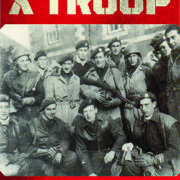X Troop: The Secret Jewish commandos of World War II By Leah Garrett
By Sheldon Goldberg, PhD
“X Troop” is an eye-opening war story about young Jewish refugees from Germany, Austria, and Hungary who came to England with one desire – to return to the continent to fight and kill Nazis and save their families. “X Troop” is the result of the author Leah Garrett’s extensive research at the Holocaust Memorial Museum, the Imperial War Museum in London, and the British National Archives in Kew, England. It is also a biography of a small number of X Troop members, personal interviews with those still alive, and a narrative of the author’s own personal insights.
Unlike the Jewish refugees in America’s Ritchie Boys who enlisted or were drafted into the U.S. Army, and who were trained in intelligence, counterintelligence and interrogation methods, the initial group of 87 X Troopers followed a different path. Initially arriving in England on many of the Kindertransports that brought young Jews to England, they lived and worked like everyone else until the war broke out in 1939. Once this occurred, they were considered enemy aliens, arrested, and sent to internment camps in England and the Isle of Man. Others were sent to Canada and 1,450 of them were sent on a traumatic two-month voyage to Australia, stuffed below decks in a filthy hold and treated horribly by the anti-Semitic officer in charge of the internees and the guards he commanded.
In early 1940, some of the internees in England were able to enlist in the Royal Pioneer Corps. In uniform but unarmed, they built bridges, dug trenches, and cleared bomb damage, but longed to be able to fight. The internees were finally released in 1942 after the Japanese attacked Pearl Harbor, and those in Australia were offered immediate transport back to England if they joined the Pioneer Corps. That same year, following a suggestion from Lord Mountbatten to Prime Minister Winston Churchill, a special unit composed of displaced nationals was created as part of No. 10 (inter-Allied) Commando. Among the separate national units, all of whom would be highly trained, Unit 3, originally called the British troop, would be composed of German-speaking refugees. This unit, Garrett writes, would become “Britain’s secret shock troop in the war against Germany.” Like the Ritchie Boys, they were trained in intelligence, counterintelligence, and interrogation, but unlike them, they also became highly trained commandos, trained to kill or capture Nazis on the battlefield. Because of the dangers these Jewish commandos would face and the missions they would undertake, should they be captured, Churchill named them, saying: “Because they will be unknown warriors…they must be considered an unknown quantity. Since the algebraic symbol for the unknown is X, let us call them X Troops.”
Having provided biographies of a few of the Jewish refugees who became X Troopers, Garrett turns to a brief biography of Brian Hilton-Jones, the Welsh officer who became X Troop’s commander and father figure who won their undying loyalty. She also highlights a key turning point in the lives of the X Troopers when, after being interviewed by Hilton-Jones, each was given five minutes to select an English name that many kept for the remainder of their lives, and a background story. Claus Asher, whose father was murdered in Dachau, became Colin Anson, Peter Arany became Peter Masters, Manfred Gans became Fred Gray, and Hans Ludwig Hajos became Ian Harris, an X Troop sergeant who single handedly convinced the entire German garrison of Osnabrück to surrender.
Using personal interviews and her own in-depth research, Garrett follows the X Troop into the war from a landing on Sword Beach in Normandy through the Netherlands and into Germany as Field Marshall Montgomery led the 21st Army Group into battles across northwest Europe. She follows individuals and small groups of X Troopers into the disaster at Dieppe, the capture of the Pegasus Bridge, the fight for Walcheren Island that opened the Scheldt Estuary allowing the Allies to be resupplied, and short diversions to Sicily and Italy before returning to Germany.
Following the Allied victory in May 1945, some of the X Troop’s mission turned to capturing Nazis and gathering intelligence and documentation that was used at the Nuremburg trials. Among other individual post-war stories, she describes the arduous journey made by Manfred Gans through a devastated Germany to finally find his parents, still alive in the Theresienstadt concentration camp.
The book’s 18 very readable chapters closes with Afterword: The Legacy of X Troop, and following some acknowledgements, an appendix that details the principal figures in the book and briefly describes their war service and what they did after the war.
“X Troop” is a must read for anyone interested in World War II history and/or the key roles played by German-speaking Jews who were able to escape Nazi Europe and return to help liberate the continent.
Volume 76. Number 2. 2022




